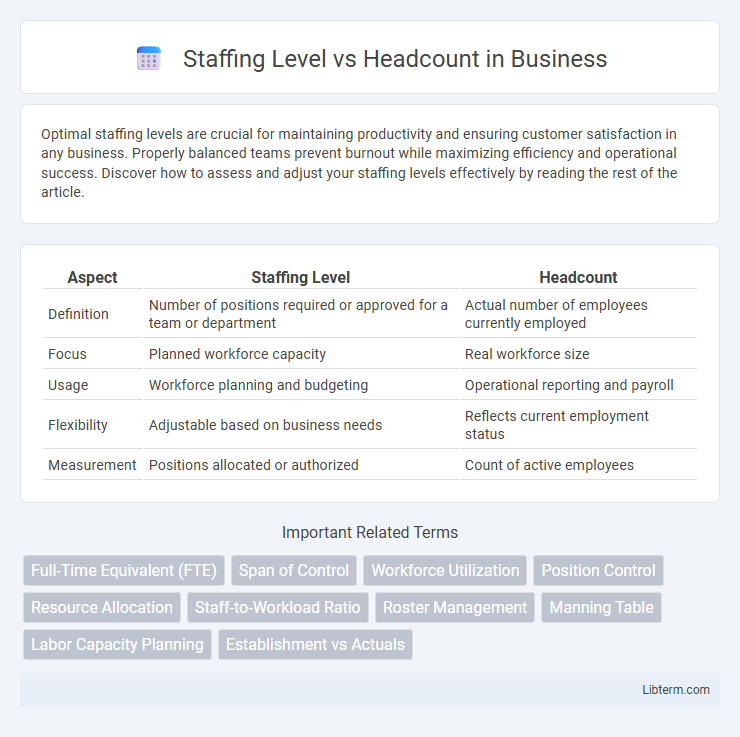Optimal staffing levels are crucial for maintaining productivity and ensuring customer satisfaction in any business. Properly balanced teams prevent burnout while maximizing efficiency and operational success. Discover how to assess and adjust your staffing levels effectively by reading the rest of the article.
Table of Comparison
| Aspect | Staffing Level | Headcount |
|---|---|---|
| Definition | Number of positions required or approved for a team or department | Actual number of employees currently employed |
| Focus | Planned workforce capacity | Real workforce size |
| Usage | Workforce planning and budgeting | Operational reporting and payroll |
| Flexibility | Adjustable based on business needs | Reflects current employment status |
| Measurement | Positions allocated or authorized | Count of active employees |
Introduction to Staffing Level and Headcount
Staffing level refers to the number of employees required to meet operational demands efficiently, while headcount represents the total number of employees on the payroll regardless of their workload or productivity. Accurate measurement of staffing levels ensures optimal resource allocation and workforce management, preventing understaffing or overstaffing. Understanding the distinction between staffing level and headcount is crucial for human resource planning and organizational performance analysis.
Defining Staffing Level
Staffing level defines the optimal number of employees required to perform business operations efficiently, reflecting workload demand and operational capacity. Unlike headcount, which indicates the total number of employees regardless of role or availability, staffing level emphasizes active, productive workforce allocation aligned with organizational goals. Accurate staffing levels ensure balanced resource utilization, cost control, and enhanced organizational performance.
Understanding Headcount
Headcount refers to the total number of employees within an organization at a specific time, providing a snapshot of workforce size without accounting for factors like role distribution or employment status. It differs from staffing level, which reflects the optimal number of employees required to meet operational demands, including adjustments for productivity and resource allocation. Understanding headcount helps businesses track workforce growth, manage labor costs, and inform strategic hiring decisions.
Key Differences Between Staffing Level and Headcount
Staffing level represents the number of employees needed to complete tasks within a specific period, reflecting workforce demand and productivity requirements. Headcount refers to the total number of employees employed by an organization at a given time, regardless of their work hours or roles. The key difference lies in staffing level's focus on optimal workforce capacity for operational efficiency, while headcount indicates the actual employee population without accounting for workload or scheduling.
Importance of Accurate Staffing Metrics
Accurate staffing level metrics enable organizations to optimize workforce allocation, ensuring operational efficiency and cost-effectiveness. Precise headcount tracking supports strategic planning by aligning human resources with business demands, minimizing overstaffing or understaffing risks. Reliable data on staffing levels and headcount drives informed decision-making, improving productivity and employee satisfaction.
Impact on Organizational Efficiency
Staffing level directly influences organizational efficiency by aligning workforce capacity with workload demands, ensuring optimal resource utilization and productivity. Headcount reflects the total number of employees but does not inherently indicate efficiency; an excessive headcount without matching staffing levels can lead to resource wastage and operational bottlenecks. Effective management of staffing levels streamlines processes, reduces idle time, and enhances overall performance, driving better business outcomes.
Measuring Staffing Level vs Headcount
Measuring staffing level involves assessing the number of employees needed to meet operational demands efficiently, often adjusted for productivity and workload fluctuations. Headcount simply counts the total number of employees regardless of their actual contribution or hours worked. Comparing staffing level to headcount provides insights into workforce efficiency, identifying gaps between the ideal resource allocation and actual personnel.
Common Challenges in Staffing Assessment
Common challenges in staffing assessment include accurately distinguishing between staffing level and headcount, as headcount reflects the total number of employees while staffing level considers the actual workforce needed to meet operational demands. Inconsistent data collection methods and fluctuating workforce requirements complicate evaluating the true staffing level, leading to overstaffing or understaffing risks. Effective staffing assessment requires integrating real-time workload analysis with precise headcount tracking to optimize labor costs and maintain productivity.
Best Practices for Optimal Staffing
Maintaining optimal staffing levels requires analyzing workload demands and employee capacity to balance headcount efficiently, avoiding both understaffing and overstaffing. Conducting regular headcount reviews aligned with operational metrics enhances resource allocation and productivity. Leveraging workforce management tools and data-driven forecasting ensures staffing levels meet dynamic business needs while controlling labor costs.
Future Trends in Workforce Planning
Staffing level reflects the optimal number of employees required to meet operational demands, while headcount refers to the total number of employees on the payroll. Future trends in workforce planning emphasize dynamic staffing level adjustments driven by AI analytics, enabling real-time alignment of workforce capacity with fluctuating business needs. Predictive modeling and automation will be pivotal in refining staffing strategies, reducing reliance on static headcount metrics and enhancing organizational agility.
Staffing Level Infographic

 libterm.com
libterm.com